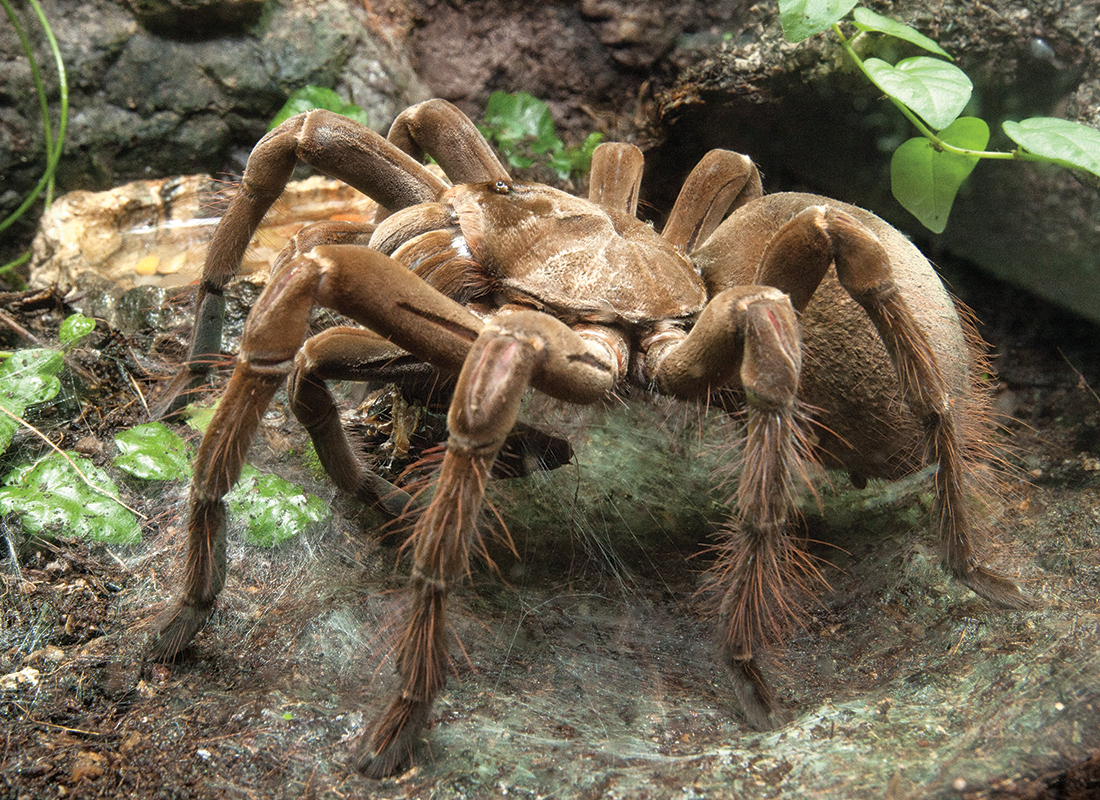BY Eston Ellis
Photography by Ken Bohn
People’s reactions vary when they encounter a hairy spider that’s big enough to cover an outstretched hand. But like the 1930s movie star Greta Garbo, tarantulas just want to be admired from a distance and left alone. You might not think of a spider that can have a leg span as large as a dinner plate as being “shy,” but all tarantulas are solitary creatures, and females spend most of their time out of sight, in the comfort of their burrow.
San Diego Zoo guests can see them at the Insect House, at Elephant Odyssey, and at the Arachnid Rescue Center at the Children’s Zoo. Chris Mooney, senior keeper, often works inside what he calls the “goldfish bowl,” where a huge glass window provides a full view of the Arachnid Rescue Center’s many spiders (and of the entomology staff, if they happen to be there, too). Chris said he enjoys watching the reactions of the people who walk through, viewing the tarantulas. “In general, people go from fear to fascination really quickly,” he said.
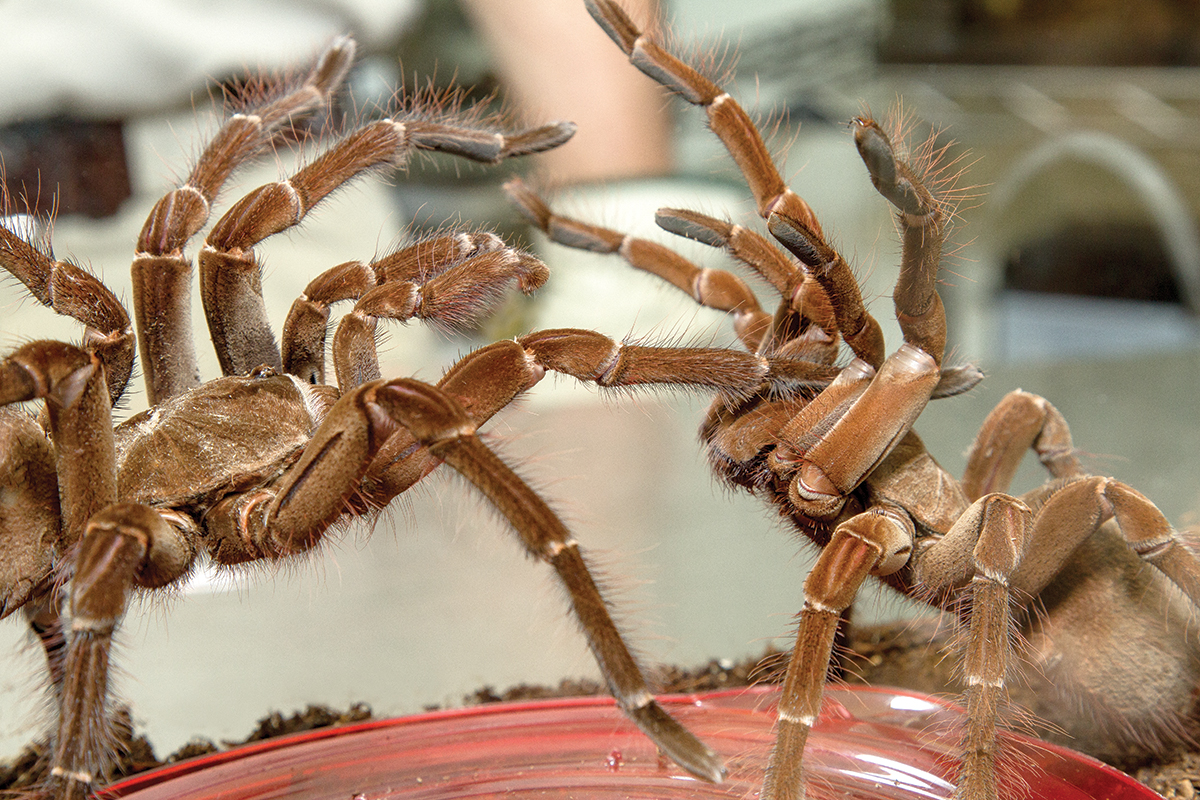
A DELICATE DANCE
Tarantula mating involves a unique “dance,” in which the male must get the female to raise her legs and abdomen. He must make all the right moves to avoid becoming her next meal.
The Truth about Tarantulas
Tarantulas are among the planet’s most efficient pest control providers. “They serve as a very important population control for countless species of invertebrates, especially insects,” Chris said. They also eat a variety of small rodents, amphibians, and reptiles. At the Zoo, many of the tarantulas—including the largest, goliath birdeating spiders (which actually rarely eat birds in their native habitats)—usually eat large cockroaches. They have a slow metabolism and may not need to feed again for several days after a meal.
Unlike many other spiders, tarantulas do not spin webs to ensnare insects. They produce silk, but they use it for different purposes, such as creating mats for molting and mating, and “hammocks” to make their homes in burrows or trees more secure. Tarantulas are ambush hunters, and they subdue their prey with venom delivered in a bite from their sharp fangs. “The mouth of the spider is a little hole structure that leads to a sucking stomach,” Chris said. The tarantula injects venom and digestive enzymes, and then sucks the fluids out of its prey.
A tarantula’s venom is effective at neutralizing small prey, but it usually isn’t strong enough to pose a danger to humans. Most species’ venom is comparable to a bee sting—however, tarantulas do have powerful jaws, so a bite would hurt. Fortunately, tarantulas in their natural habitats are just as eager to avoid a confrontation with humans as people are to avoid tarantulas. “There is very little risk to people from tarantulas, even those you might see while hiking or in your backyard,” Chris said.
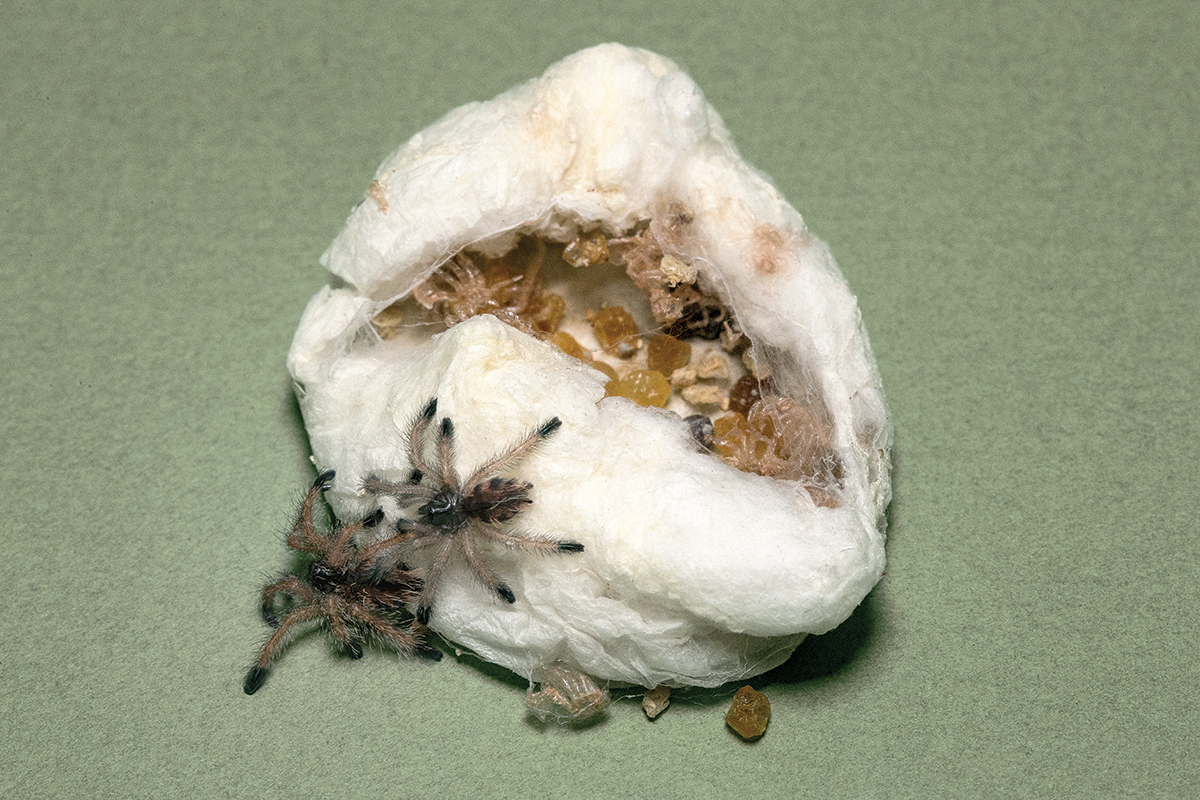
KIDS HAVE IT SOFT
When they hatch, young tarantulas emerge from a silk cocoon that may contain 75 to 1,000 eggs.
Around the World
Tarantulas are found on every continent except Antarctica, and most species live in South America. In all, there are about 900 species of tarantulas in the Family Teraphosidae, in at least 123 known genera. There are two main types: New World, from South, Central, and North America, and Old World, from Asia and Africa.
New World tarantulas tend to have milder venom than their Old World counterparts. However, they possess an additional defense adaptation utilizing urticating hairs—tiny hairs with barbs on the end—on their abdomens. When these hairs are released, they create a fine cloud of tiny irritants, which can become lodged in a potential predator’s eyes, skin, and mucus membranes. Old World tarantulas do not have this adaptation, but some have developed stronger venom and are more defensive than New World tarantulas.
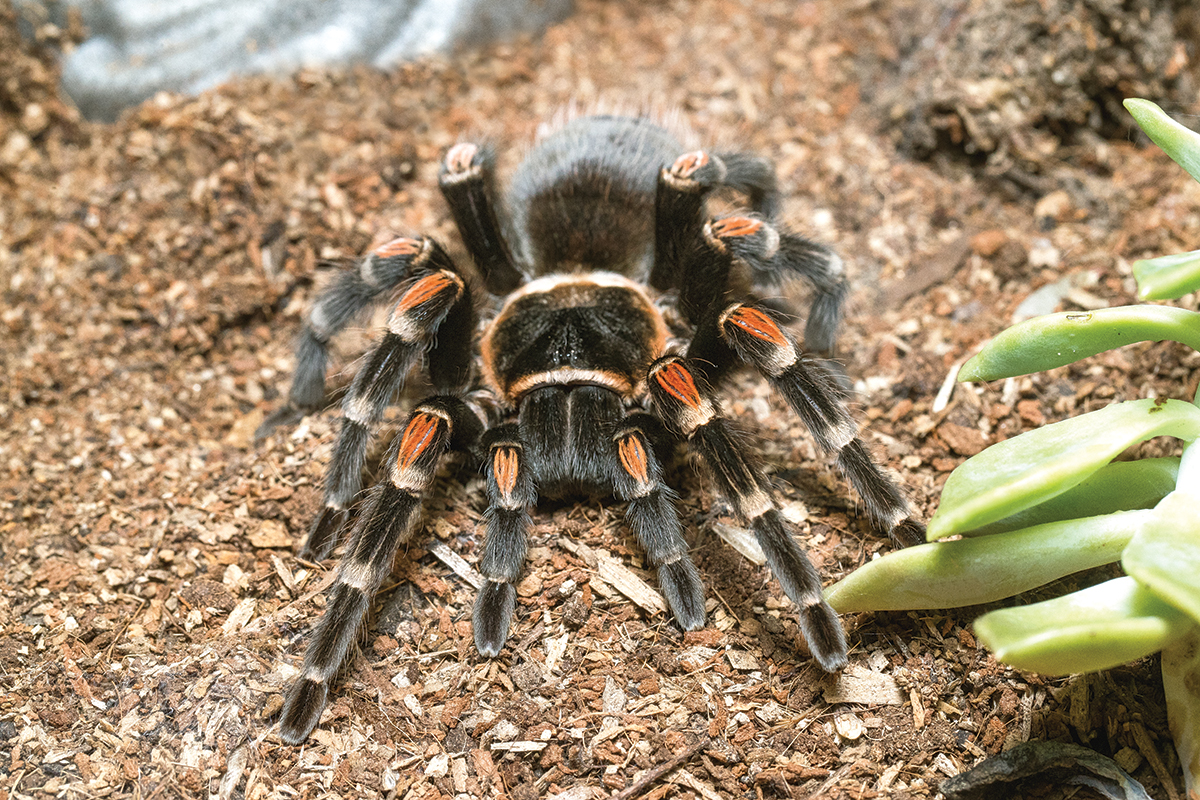
HAIR TRIGGER
New World tarantulas, such as the Mexican fireleg, have tiny barbed hairs on their abdomen that can be used as a defense against predators. They dislodge those hairs by rubbling their legs against them, creating a fine cloud of tiny airborne irritants.
Anatomy of a Tarantula
All tarantulas are big, and sizes vary depending on the species. While the males in the genus Avicularia have a 4-to 5-inch leg span, the largest male goliath birdeating spiders have a 4- to 5-inch body and a diagonal leg span of up to 11 inches. Like other spiders, tarantulas have eight legs, and their body is made up of two segments: a cephalothorax and an abdomen. In addition to their eight legs, tarantulas have a pair of sensory appendages called pedipalps near their fangs, which look like short legs. They use these accessory structures to hold and manipulate food. Male tarantulas also use them in mating to deposit sperm and to secure the fangs of a female tarantula.
As tarantulas grow, they molt—discarding their old exoskeleton. “If you ever find a hairy, empty shell of a tarantula, usually sitting on a silk mat, it is a discarded exoskeleton,” Chris said. When it is time to molt, the spider increases vascular pressure in order to rupture the old exoskeleton, and then slowly contracts and expands its limbs to cast off the old shed and reveal the new exoskeleton that has formed beneath. “The freshly molted tarantula at first is wet, soggy, and soft,” Chris said. “The animal hides out for a few days until the exoskeleton hardens up, because its urticating hairs and fangs are too soft for it to defend itself.”
While a female tarantula can continue molting many times over a lifespan, males normally have an ultimate (or final) molt, since their lives are considerably shorter. “Females can live up to 20 years, and that’s not unheard of; but for males, 6 years is a ripe old age,” Chris said.
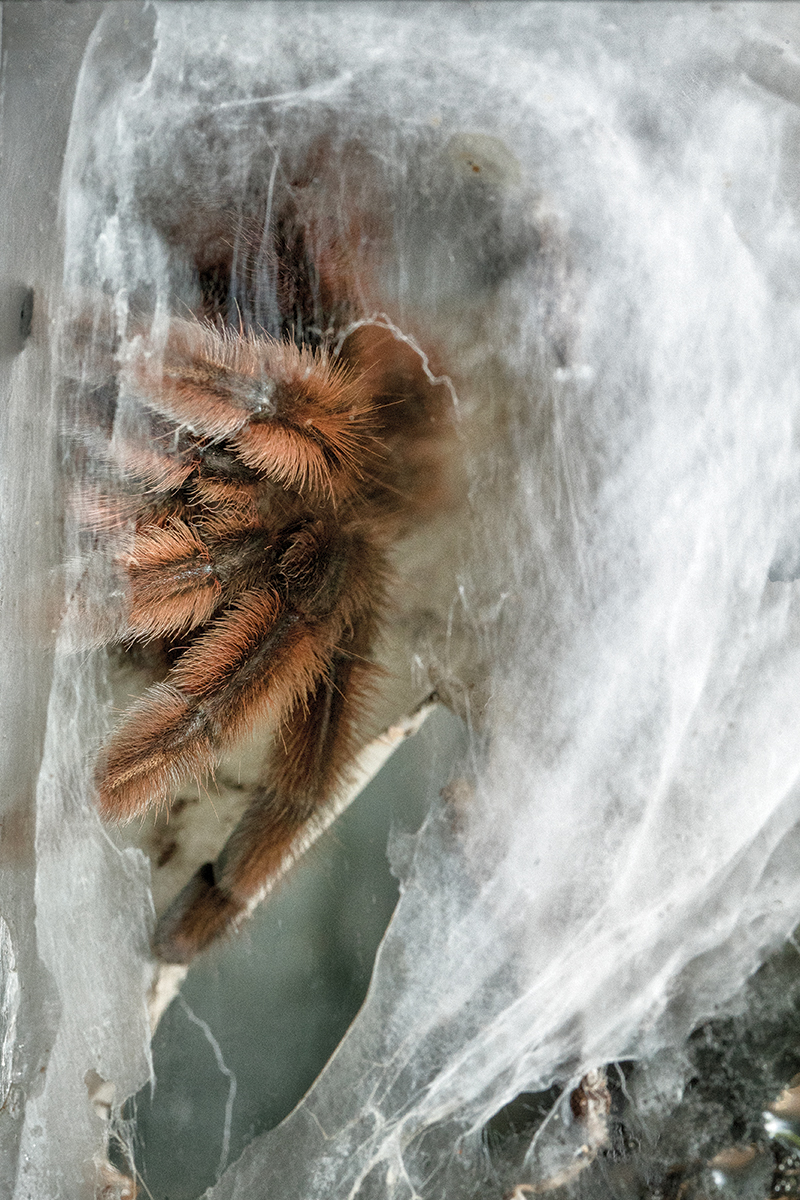
A SPIDER’S HAMMOCK
Tarantulas do not spin webs to catch prey, but create silk structures to make their homes in trees and burrows more secure, and more comfortable.
Tarantula Tarantella
For tarantulas, mating requires a complicated dance. While a female tarantula spends most of her time in her burrow, mature males are out searching for a mate. When a female is ready, she will put out a silk “welcome mat” at the entrance to her burrow, Chris explained. “She can feel movement on it, which may be a meal or may be a mate. When a male finds the ‘welcome mat’, he starts drumming on it. If the female is interested, she may decide to dance with this guy, or she may eat him.
“They do an elaborate combination of dance and wrestling match,” Chris said. “Tarantulas have indirect fertilization, so the male has to get the female’s abdomen and legs up, and reach up with his pedipalps to insert his sperm. If he makes a wrong move, the dance is over.”
After mating, the female lays between 75 and 1,000 eggs and seals them inside a protective silk cocoon. She guards the eggs until the young hatch, six to nine weeks later. The spiderlings head out on their own after about three weeks.
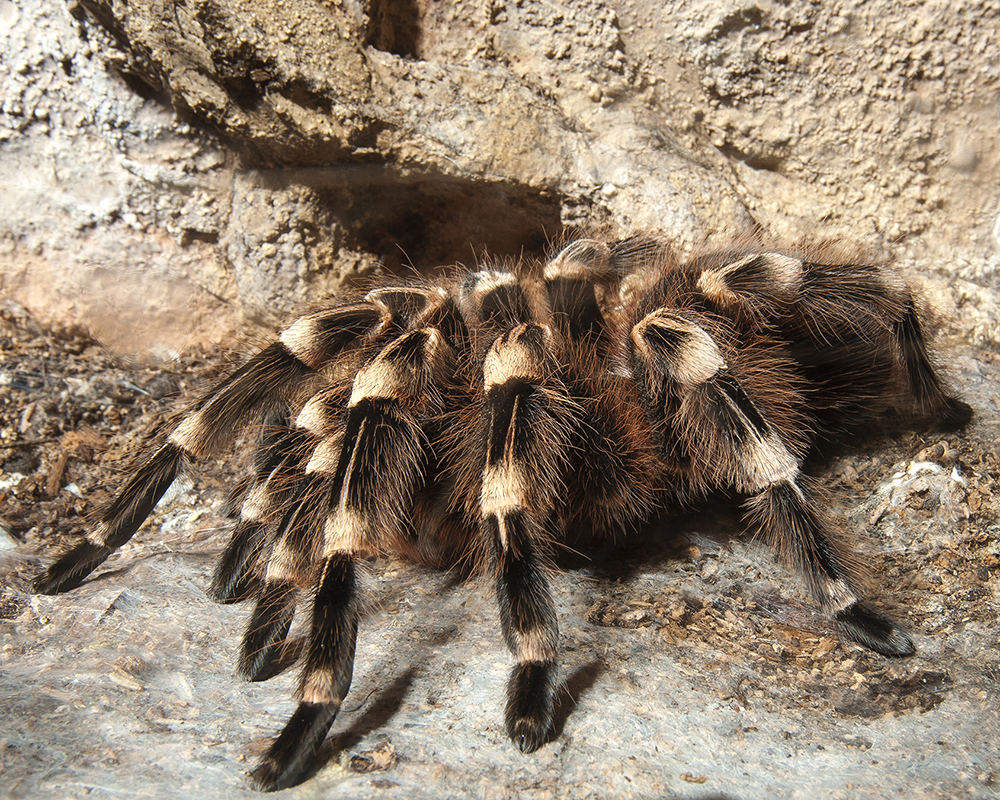
THERE’S NO PLACE LIKE HOME
While male tarantulas are often out looking for mates, female tarantulas spend most of their time in the comfort of their own burrows.
Tough-looking, but Vulnerable
Tarantulas may look tough, but they are actually quite prone to injuries from accidents, such as falls. For that reason, keepers rarely handle the tarantulas at the Zoo. “Tarantulas are big bodied and heavy, but they are so fragile,” Chris explained. “If one were to run off my hand and fall on the ground, there is a good chance that fall would kill it. The exoskeleton could rupture, and it could bleed to death quickly.”
Another major threat to tarantulas is wildlife trafficking. Many tarantula species populations are threatened in the wild by overcollection for the pet and hobby trade. “That is the reason why the rarer species had to have CITES [Convention on International Trade in Endangered Species treaty] protection,” Chris said. “There is a big illegal pet trade in tarantulas, so potential owners need to make sure they are sourcing from a breeder who is doing it right, offering tarantulas that are bred in captivity.”
 While female tarantulas can live up to 20 years, males typically live no longer than 6 years.
While female tarantulas can live up to 20 years, males typically live no longer than 6 years.
Past smuggling attempts have been as brazen as transporting a trunk full of adult spiders across the border in a car, and as hard-to-detect as sending tiny spiderlings through the mail, concealed inside soda straws. When law enforcement authorities discover illegally trafficked tarantulas, they often place them with the Zoo’s Arachnid Rescue Center.
The Arachnid Rescue Center provides a safe home for many spiders that have been confiscated by law enforcement agencies, in cooperation with the U.S. Fish and Wildlife Service. The center offers temperature- and humidity-controlled individual enclosures for spiders of several threatened species. It currently houses more than 25 tarantulas—including Mexican fireleg, pink-toed, Brazilian whiteknee, and goliath birdeating tarantulas.
While working with the rescued tarantulas at the Arachnid Rescue Center is rewarding, it is equally gratifying to see Zoo guests take a greater interest in these remarkable creatures—at the center, and in keeper talks at the Zoo’s Insect House, Chris explained. “When I see how fascinated kids are by our tarantulas, watch them point them out to their parents, and see them want to learn more about them, that’s what it’s all about for me.” Convincing people that tarantulas aren’t scary isn’t easy, but that’s something Chris does almost every day at the Zoo. “I love the challenge,” Chris said. “You may not think you like tarantulas, at first. But give me a chance: I can get you past that.”

